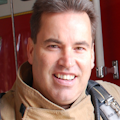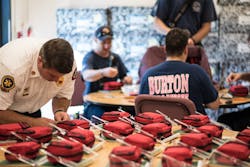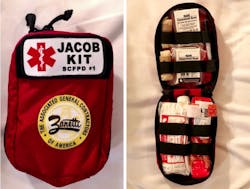It is imperative that the fire service once again rise to proactively address the concerns and fears faced by their communities. As some of the most highly respected and trusted members of these societies, firefighters are in the best position to influence and lead change, as well as spearhead programs and projects that speak to the insecurities and uncertainties in many U.S. households. The fire service traditionally addresses many of these issues in a reactive manner after a tragedy, but just as is the case with fire safety, more lives can be saved, and our mission better fulfilled, through proactive actions. This also further supports our image as a community service that provides a constant daily value to the lives of its citizens.
I have long advocated that the fire service no longer view itself as the kindly neighborhood civil servants who respond to random incidents of misfortune, but rather as troops on the front line of national homeland security. This approach is in keeping with the Presidential Policy Directive 8 National Preparedness Goal as well as national security priorities. Further, this is in line with the direction of national- and state-level emergency preparedness, as well as federal and state funding pots.
The National Preparedness Goal outlines the achievement of national security through community resiliency. Resiliency involves the ability of a community to not only prepare and respond to disasters, but also recover quickly. The core of this concept is keeping disasters at the lowest possible levels of government, which is where a fire department resides. To achieve this resiliency, communities are charged with assessing its risk and creating programs and policies to prevent, protect, mitigate, respond and recover from that risk.
Identifying a risk
For the Burton Fire District in Beaufort County, SC, firefighters identified school shootings as a risk that needed to be addressed. Not only are the schools within the fire district at equal risk as other schools across the nation for such an event, but the firefighters felt that their schools had an elevated risk due to the three neighboring military installations whose children attend those schools. With community resiliency and the national preparedness system in mind, and after several school shooting response drills with law enforcement agencies in Beaufort County, Burton firefighters felt that there were continued risks within the response system that needed to be addressed to efficiently mitigate a school shooting. The primary risk that was identified was delay in treatment.
Specifically, no matter how many times a school shooting drill was conducted, and no matter how efficient emergency crews were in their response, there remained a significant time gap between when a child suffered a wound and when a trained emergency responder was kneeling by their side. With half the blood volume as an adult, children cannot afford that loss of time. As such, to better prepare their schools (community partners) to address this risk and mitigate such an event, the Burton Fire District created the JACOB Kit program.
The trauma kit was named after Jacob Hall, a 6-year-old student wounded in a 2016 school shooting in Townsville, SC. Jacob survived the wound but died three days later due to massive blood loss. Burton chose to name the kit after Jacob not only to remember him, but also to emphasize to teachers and staff the relative importance of the kit and their training.
In addition to installing the kits, all teachers and staff will receive training by Burton firefighters on how to use items in the kit and how to “Stop the Bleed.” Firefighters stress that not only does this training benefit the students and staff at the school should an event occur, but also their family and friends at home, on vacation or traveling.
Training on how to “Stop the Bleed” will be an annual event for school personnel who have the kits, and the kits will be inspected annually as well to ensure they are stocked and serviceable. The only items within the kit that have an expiration date are the chest seals, and there are plans in place to replace those items when they expire in five years.
The life-saving tools provided by the JACOB Kit are beneficial for the teachers and staff in the school, and also provide for additional resources that are now prepositioned on site within a target hazard for emergency workers to use. Through the JACOB Kit program, and by empowering school teachers through training and education, the school staff is now able to fill that time gap risk, thus better mitigating the event and enhancing recovery by reducing injury and death. Also through this program, the Burton Fire District is expanding its role and value from a response only agency, to an agency that is proactive toward achieving community resiliency in accordance with the National Preparedness Goal and homeland security. This also increases the fire district’s value by addressing a risk and fear that today’s citizens have.
The Burton Fire District has completed installation of the kits in all of its elementary schools, and fire departments throughout Beaufort County are starting programs for their schools as well. To date, five county fire departments have lead the installation of a JACOB Kit program in over 10 schools throughout Beaufort County. County fire officials have also been assisting fire departments across the South Carolina and the nation in starting programs for their schools. The kits are currently being funded through local donations and grants, although school district board members have discussed the possibility of funding the program in the future for schools still in need of the kit.
Be proactive
The JACOB Kit serves as an example of how a local fire department can take the lead in community resiliency in a nontraditional, proactive way. Such a program is not only in accordance with the National Preparedness Goal, but it also demonstrates a daily value and commitment to the community by addressing a modern threat that is causing fear and insecurity in every home, just as the term “fire” once did.
Fire departments need to realign themselves as solutions—or supporters and contributors toward the solutions—to the threats and fears of today’s communities. While fire is such a threat, it often does not make the top of the community concern list (if it makes the list at all). Today’s fire departments need to see themselves beyond fire and EMS response services, and expand into the role of a community-based service that is fulfilling the National Preparedness Goal, achieving community resiliency and ensuring homeland security.
There are no more trusted and respected members of any community than firefighters, and no other profession allows its individuals such opportunity to influence change and make a difference. Whether through a JACOB Kit or another program that addresses a community risk, firefighters should support solutions to those risks or even better, be the ones who lead it.
For more information about the program, email [email protected] or visit www.facebook.com/SCJACOBkit.
About the Author

Daniel Byrne
DANIEL BYRNE is a community support officer for the Burton Fire District, Beaufort County, SC, and a retired assistant fire chief of training for the Georgia Air National Guard 165th Fire Department. A third-generation firefighter, he holds an associate degree and a bachelor’s degree in fire science as well as a master’s degree in public administration and disaster management. Byrne is an alumnus of the National Fire Academy. He received state and local awards for public relations and educational programs as well as community partnerships and served as a conference presenter and keynote speaker.

